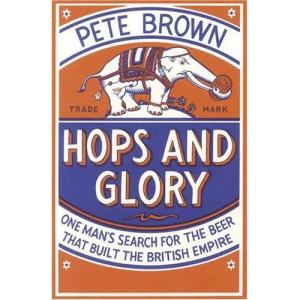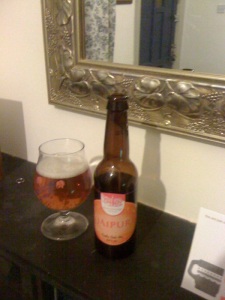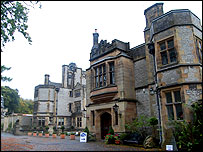In Three Sheets To The Wind, Pete Brown decides that the Belgian people are committing some kind of massive practical joke on the rest of the world. Perceived wisdom seems to be that Belgium is a tedious country with nothing to see beyond the wonderful beauty of Bruges (if you haven’t been to Bruges, go. If you can’t afford to go, watch In Bruges, it’s very funny and makes the city look as stunning as it actually is).
This, as Pete Brown attests is very wrong. Not only are Belgian people, almost to a man (or woman) very entertaining, but their cities are fantastic and, most of all, the make the most interesting and diverse beers you can dream off (the legendary beer writer Michael Jackson wrote a great book all about the range and brilliance of Belgian beers).
My affection for Belgium brought me back to the country (via a quick trip to Lille, which is in France, but was once a part of Flanders, which is in Belgium) for the third time and coincided with drinking a fair few fantastic beers.
So, the holiday starts with leaving the Eurostar (a truly great way to travel) and arriving in Lille. This being a beer blog, I’m not going to go into detail about the architecture (partly because I can’t), the historic points of interest or the culture I’ve seen. Rather, I’m going to launch into the beer, bars and occasionally the food (the three are intrinsically linked).
So Lille, we hit a bar called Les Trois Brasseurs. It seems like a lovely little micro-brewery and brasserie (although it turns out it’s actually a small French chain with micro-breweries in most of it bars, but Lille is the original site). We start off with a tasting platter of four of their beers, before I pick out their stout (smokey, malty thick and chocolatey) and my girlfriend goes for the blond (a strong, Belgian style blond ale, crisp, simple and refreshing). We wander the streets, doing some culture and that, getting food, before returning for a 75cl bottle of their speciality beer, La Belle Province, a dark red beer which is refermented with maple syrup. It’s good, but far from stunning. An ample warm up for the treats of Belgium though.

Antwerp Train Station - not bad, eh?
Lille being very far North in France, and Belgium being tiny, Belgium can be travelled around at very little cost and in very little time, so we start with two nights in Antwerp (0r Antwerpen, if you’re being Flemish). Antwerp is very wealthy. They have the biggest diamond market in Europe, a fair few champagne bars and a thriving fashion scene. It’s a great city for wandering around and gawping, with magnificent squares, some amazing imposing architecture and a giant sculpture of a hand in the middle of the main shopping street (Antwerp means thrown hand, apparently).
That doesn’t mean it’s all swanky, fancy beers here though. We start our Belgian drinking at De Vagant, an old-fashioned style bar that specialises in Jenever (a kind of Belgian gin) but also stocks a good range of beers. Plus, they do hearty portions of soup and bread for a mere €3 and have a lovely old cat milling around. It’s a classic old style bar, long wooden benches, stone tiles, candles and quiet classical music piped across (all the best bars play classical music, it’s probably why drinking here is so placid with no hint of aggression). We have a couple of beers, including a sweet and dark Grimbergen, and De Konnick, a good, but unexceptional pilsner brewed in Antwerp. It’s the local brew of choice, apparently.
It’s actually surprising how many people drink pils here, instead of the richer, stronger abbey-style beers. But then if you spent every night on beers that range between 7% and 12%, your liver would struggle, I guess.
The real highlight, drinking-wise in Antwerp comes in Kulminator that night. A small, crammed smokey bar with strings of sausages flopping around the bar, two cats dancing around the window front, loads of cheese (including aged stuff from the Rochefort and Orval breweries) and shelf-upon-shelf and crate-upon-crate of beer. What’s really noticeable is the ancient, dust-laden bottles on the top shelves. See, while Kulminator do a great range of standard bottles, and some amazing draft beers (we take two very strong, dark, Christmas ales, a Stille Nacht and Bush Noel) and, most interesting of all, lots of very old beer.
The back of the menu is selling beers for beyond €30 a bottle, and it’s because they deal in vintaged bottles of beer. You can, if you ask nicely and have the cash, get 25 year old geuze, or two year old Chimay, or, just about any Belgian beer you can ever want.

An old guild building in Ghent
One way to tell an especially strong beer, is a warning at the bottom of the menu that they will only sell you three of said beer. Thus was the case when we visited Ghent and Het Waterhuis Aan De Bierkant. This lovely canal-side bar (Ghent, like Bruge, is full of canals. In fact, Ghent is like a larger, more lived in Bruge. But not quite as beautiful). In this bar, one of their house beers (or Huis Biers – Flemish words often look and sound like English word spoken in a childish tone, thanks lot is “dank u well”), named Klocke Roeland – named after a bell in the city’s Belfry, the middle of three big towers in the city – is rich, strong, slightly red and full of aniseed and banana notes. It’s gorgeous, heavy and kicks in at over 11%.
In retrospect, a beer that strong wasn’t the best thing to drink before going to t’Velootje. Velootje (meaning small bicycle) is, by far, the strangest bar I have ever entered. As you reach the bar there is nothing, other than an Orval plaque, that suggest you are at a bar. The stack of bikes pilled outside the bar, the stiff door that needs a real shove to open, the long curtain than you’re then faced with, then the dim, smokey darkness, don’t scream ‘this is somewhere you would be welcome’.
As your eyes adjust to the gloom, it doesn’t get any easier to get your head round. The ceiling is full, absolutely packed, with hanging, rusting bicycles. The walls carry old beer posters and religious imagery. The tables (two long wooden tables with matching benches either side) have paper and packaging piled around them, alongside a pail holding archaic beer mats (all of them filthy) and religious artifacts and tat. In a corner an old man in shorts and sparkling tights skulks by a fire. A computer sits by him with a cat curled up nearby.
After a few minutes, the tight wearing man comes up to us. “So, you want a beer, he asks?” “Yes”, we reply. That the last option we’re given. He heads off to the back and returns with a beer called Kerst Pater, a 9% sherry-ish Christmas beer, complete with a deep, curranty flavour. We get no glass, and don’t really want to ask.
While we chat with the drunken locals (who work through Duvels and Monty Python quotes at speed), the owner approaches us. “What are your names?” he asks, and we tell him. “The police might arrive, if they do, we are friends, and you are not paying for your beer.” Ok, we nod in agreement and take his name, Leuven, for surety.
Sure enough, the police do arrive (the locals give us a mixed bag of reasons, a trouble neighbour, the open fire, the lack of fire exits and ventilation, the fact it’s an anarchist bar) and stick around for a fair while filling in forms, while we do our best to appear like friends enjoying a few beer in Leuven’s open front room.
Thankfully, the police soon leave, and we ask Leuven for one more beer. He returns with a monster that I know was 12% (my head told me that much the next morning), again with no glass. We drink it willingly, singing along with Leuven’s choice of music (60s psychedelic pop, 50s rock’n’roll, great stuff) as well as some Flemish drinking songs, and, odd enough, Abba’s ‘Thankyou For The Music’.
That’s definitely the last beer of the night. We leave our new friends and head off back to our room. “Will you be open tomorrow?” we ask. “Maybe,” he says. “I might clean”. We somewhat doubt that.
There’s one more city left, our favourite and two more bars to tell you about. Bruges, as I have already mentioned, is magnificent. Beautiful canals, nothing but gorgeous old architecture, grand town houses and old arced bridges. It’s all you could hope it would be, especially if you avoid the two bustling shopping streets and all the tourists.
The bars are good too, if you leave the obvious places and tourist traps. De Garre is, probably, the best. It’s hidden down a narrow alley between two famous old squares. You would barely notice it was there, but after one visit you’d be heading right back. The small, two floor bar is fancy, but not pretentious or too expensive. It’s rustic-feeling, with old wood tables, wonky twisted stairs and a squat bar. It’s table service done with aplomb and the real treat is their own beer Tripel Van Der Garre. A proper, powerful Belgian Tripel that, like the rest of the beers at the bar, comes complete with a small portion of tasty cheese (truly one of the best things about drinking in Belgium).

Dulle Teve in t'Bruges Beertje
Perhaps the biggest draw for beers lovers though is t’Bruges Beertje (aka The Bruges Bear). You can tell the Bear is a beer-lovers haven because it has a photo of Michael Jackson (the writer) above a mantelpiece, a thick, bound beer menu and loads of people in it all drinking great Belgian beer.
Like Kulminator, there’s plenty of aged stuff here, and loads of Christmas beers too. I go for Straffe Hendrick though, a tripel beer brewed by Halve Moon brewery within the walls of Bruges. It’s actually not as great as I had hoped (having tried and enjoyed the brewery’s blond beer Bruges Zot and its dark sister on a previous visit to Belgium), strong, certainly, but lacking any distinctive flavours. Much better is the Dolle Brewer’s (literally, mad brewers) Dulle Teve (aka Mad Bitch), it packs a massive punch and comes with flavours of tropical fruits and licorice in its golden sheen.
A fellow Brit recognises us from our trip to De Garre and indulges in some serious beer one-up-manship with us. ‘Oh so you like Rodenbach? Have you tried the Gran Cru?’ ‘Yes, yes we have’ and so on. His beery tales and experiences far over shadow ours though, and we give up. His parting shot is to recommend the Christmas beer by Gouden Carolus. When he returns to our table a little later, he’s upset to see we haven’t tried his suggestion. Lucky for us, he vanishes for a moment, and returns with a glass of the stuff, a deliciously thick, malty, treacly beer that’s a perfect Christmas warmer. What a nice chap.
And with that, we bring a close to my commentary on Belgium. This is obviously nowhere near a full account of the holiday. We visited museums, churches and galleries (including an Anime exhibition in an old monastery in Ghent), saw some really famous paintings by the Belgian masters (all of them deeply religious), loads of amazing guild buildings, walked along canals, trod the streets of the city and caught up with a Belgian friend. Oh, and ate a fair bit too (plenty of cheese’n’beer, plus the obligatory soups and, best of all, a beef stew made using Leffe).
If you’ve read this and not visited Belgium before, I hope you might reconsider now.
Filed under: Beer, Belgian Beer, Food and beer, Uncategorized | Tagged: Antwerp, Bars, Belgian Beer, Belgium, Bruges, Ghent, Lille, Pete Brown, Trappist Beers, Travel Writing | 8 Comments »











